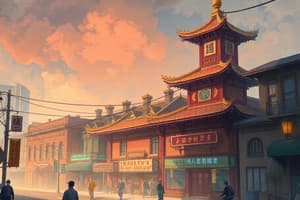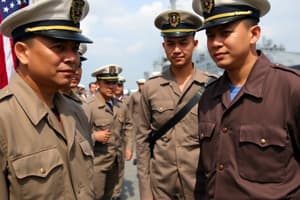Podcast
Questions and Answers
Where is Ronald Takaki (the author) from?
Where is Ronald Takaki (the author) from?
Palolo Valley, Oahu, Hawaii
What are elderly Filipinos called?
What are elderly Filipinos called?
manongs
Name a few Asian American ethnic groups.
Name a few Asian American ethnic groups.
China, Japan, Philippines, India, Vietnam, Laos, Cambodia
Asian Americans seemed ubiquitous (prevalent) on U.S. college campuses.
Asian Americans seemed ubiquitous (prevalent) on U.S. college campuses.
Recently, Asian Americans have become very visible.
Recently, Asian Americans have become very visible.
What percentage of California's population is Asian?
What percentage of California's population is Asian?
What did the Immigration Act of 1965 change regarding Asian immigration?
What did the Immigration Act of 1965 change regarding Asian immigration?
List the top three Asian populations in the U.S.
List the top three Asian populations in the U.S.
What major racial slurs did Lieutenant Colonel Oliver North face?
What major racial slurs did Lieutenant Colonel Oliver North face?
What misconception exists about Asian vs European immigrants?
What misconception exists about Asian vs European immigrants?
What was the purpose of the Tydings-McDuffie Act of 1934?
What was the purpose of the Tydings-McDuffie Act of 1934?
What did the 1922 Cable Act state?
What did the 1922 Cable Act state?
What is 'ethnocentrism'?
What is 'ethnocentrism'?
What does 'cognitive dissonance' refer to?
What does 'cognitive dissonance' refer to?
What is the Mudsill theory?
What is the Mudsill theory?
What does 'legislative violence' mean?
What does 'legislative violence' mean?
What is cosmology?
What is cosmology?
Why couldn't Asians become U.S. citizens historically?
Why couldn't Asians become U.S. citizens historically?
Flashcards are hidden until you start studying
Study Notes
Author Background
- Ronald Takaki hails from Palolo Valley, Oahu, Hawaii.
Cultural Terminology
- Elderly Filipinos are referred to as "manongs".
Asian American Ethnic Groups
- Includes Chinese, Japanese, Filipinos, Indians, Vietnamese, Laotians, Cambodians, among others.
Asian American Presence in Education
- Asian Americans are prevalent on U.S. college campuses, confirming their visibility and impact.
Demographics & Population Statistics
- Over 50% of San Francisco public school students are Asian; 1/4 of San Francisco's total population is Asian.
- Asian populations have been a majority in Hawaii for nearly a century with over 300,000 Chinese in NYC, forming the largest Chinese community outside China.
Growth of Asian Population
- Asians constitute 9% of California’s population, surpassing Black populations; they represent the fastest-growing ethnic minority in the U.S.
- From 1970 to 1980, the Hispanic population rose by 38%, whereas Asian numbers increased by 143%.
Immigration Act of 1965
- This act allowed Asian immigrants back into the U.S. with a quota of 20,000 from each country. Family members could immigrate without restrictions.
- By the mid-1980s, Asians made up 2.1% of the U.S. population, a significant increase from 0.5% in 1960.
Asian Population Rankings
- Chinese largest group (1,079,999), followed by Filipinos (1,052,000), Japanese (766,000), and others.
Racial Issues in Historical Context
- Senator Daniel Inouye faced racial slurs despite his distinguished military service in WWII.
- Historical misconceptions depicted Asians as temporary laborers ("sojourners") while Europeans were seen as settlers.
Immigration Trends
- Immigration from Asia saw about 1 million arriving between 1849-1924, halting with the Immigration Act.
- Between 1965 and 1985, an additional 3.5 million Asians immigrated.
Cultural Representation and Misunderstandings
- Maxine Hong Kingston's "China Men" illustrates Asian immigrant struggles and perceptions of labor.
- Asian immigrants expressed their culture through carvings at Angel Island Immigration Station in San Francisco Bay.
Legislative Impact on Citizenship
- Naturalization laws historically excluded Asians based on race, focusing on characteristics like complexion and eye shape.
- The Tydings-McDuffie Act (1934) limited Filipino immigration significantly, while the Naturalization Law of 1790 allowed citizenship only for "whites".
Economic Exploitation
- The dual-wage system favored white laborers and exploited Asian workers in various industries, leading to ethnic antagonism as per Bonacich’s theory.
Identity and Experience
- Many Asian immigrants, initially believing they were temporary workers, faced long-term settlement due to social and economic mobility.
- Ethnocentrism and racial perceptions led to segregation in exercises of power and civil rights.
Government Policies and Ethnic Relations
- Historical policies like the Chinese Exclusion Act (1882) and National Origins Act (1924) systematically discriminated against Asian immigrants while permitting European influx.
Past and Present Narratives
- Intellectuals like Walt Whitman envisioned America as a "teeming Nation of nations," reflecting on the diversity that characterizes the nation.
- The portrayal of society’s diversity appears in literature, including Melville's works depicting cooperation among diverse ethnic groups.
Cultural Identity
- Cosmology, ideology, epistemology, ontology, and cognitive dissonance shape societal perspectives and the experiences of various ethnic groups in the U.S.
- Power dynamics are evident in legislative violence, influencing the lived realities of marginalized communities.
Historical Events
- King Kalakaua's greatest ally was his sister, showcasing the significance of familial networks in leadership.
- Aaron H. Palmer advocated for Chinese laborers, linking to broader historical labor narratives.
Economic Theories
- Mudsill theory posits that a lower class supports an upper class, explaining economic structures and class disparities in society.
Studying That Suits You
Use AI to generate personalized quizzes and flashcards to suit your learning preferences.




